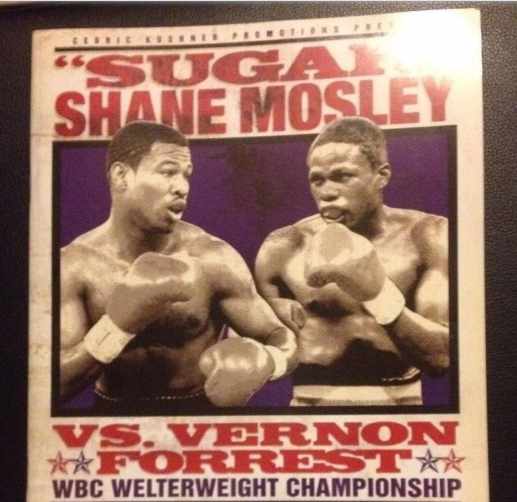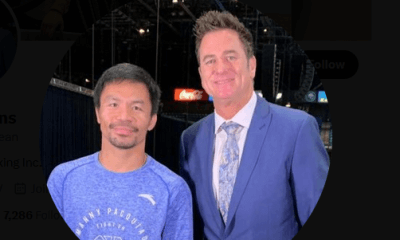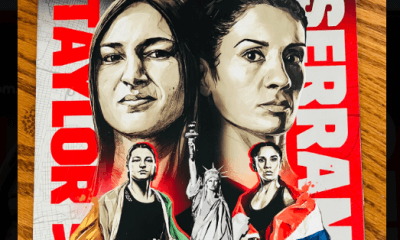Featured Articles
Avila Perspective, Chap. 93: Best of Prizefighting

Avila Perspective, Chap. 93: Best of Prizefighting
Boxing powers are suggesting a return could be imminent but minus the clatter and chatter of a live audience. The threat of death by virus still looms large.
No fans allowed.
Television and streaming devices pay for the bulk of major prize fight confrontations so promotion companies like Top Rank, UFC, and Matchroom Boxing are considering a return next month, but minus the fans.
It got me thinking.
Though the actual combat participants may or may not be affected, whether its boxing or MMA the audience or fans will truly be missing a major reason they love prizefighting.
Watching a prize fight live in person just cannot be beat by any other sport. Though I love baseball, basketball, football and soccer without the flopping, when it comes to watching a world championship fight those other sports take a back seat.
Over the years I’ve witnessed some incredible feats in person. Watching fights on television is fine, but watching in person I’ve witnessed remarkable displays of physical talent that stand out. Here are some of the things I’ve seen:
Fastest Combinations with Power
Manny Pacquiao, Roy Jones Jr. Oscar De La Hoya
Manny “Pacman” Pacquiao could reel off a powerful combination faster than most people could think. He did it against Marco Antonio Barrera and then did it again. There are a lot of fighters that have fast hands, but few could muster up a fast combination with power behind it. Pacman could. Today, not so much, but when he began mowing down the featherweight division it was something to behold. He seemed like a freak of nature.
Roy Jones Jr. could hit you with a lightning combination as could Oscar De La Hoya in their primes. Any one of their lightning blows could result in seeing another fighter unconscious.
Fastest Feet
Mark “Too Sharp” Johnson, Roy Jones Jr., Guillermo Rigondeaux
When Mark “Too Sharp” Johnson dominated the flyweights, he was near impossible to hit. He would dart in and out quicker than anyone I have ever seen. If he didn’t want someone to hit him, they could not hit him. But he did occasionally take some chances or else everyone in the audience would have fallen asleep from boredom. In his prime, he was untouchable.
Roy Jones Jr. was pretty fast on his feet too. What makes Jones special was he did it in the light heavyweight division for years. When those legs got older and heavier is when the competition finally caught up to Roy Jones. I still remember when he fought the late Julio Gonzalez at the Staples Center and though 10 feet away Jones covered the 10 feet distance in the blink of an eye and connected with a left hook. I couldn’t believe my eyes.
Cuba’s Guillermo Rigondeaux also has very quick feet and deserves honorable mention.
Best Left Hook
Oscar De La Hoya, Felix Trinidad, Mike Tyson
It was a sound I’ll never forget when Oscar De La Hoya connected with a left hook to the jaw of Rafael Ruelas in their lightweight unification battle in Las Vegas on May 6, 1995. It sounded like a bazooka blast. De La Hoya could unleash a left hook so potent and seemingly from any angle. When he knocked out Oba Carr that blow was almost invisible and left the talented fighter unable to defend himself. But that knockout against Ruelas when they met outdoors at Caesars Palace remains the single loudest punch I’ve ever heard in person. That sound remains vivid in my memory.
Puerto Rico’s Felix Trinidad also possessed a lethal left hook and it was fully loaded when he dropped and stopped David Reid outdoors at Caesars Palace in Las Vegas.
“Iron” Mike Tyson also had one heck of a left hook too. I only saw Tyson fight once live and witnessed his speed and power when he eliminated Orlin Norris when they met in Las Vegas. He was a human tornado.
Best Right Cross
Floyd Mayweather, Roy Jones Jr. Juan Manuel Marquez
Floyd Mayweather rarely knocked out opponents after he entered the welterweight division, but in his super featherweight and lightweight days that lightning quick right cross was deadly. Nobody throws a more perfect right cross than Mayweather. It is short, concise and undetectable. It’s also one of the hardest punches to land when the opposition knows it’s coming. Yet, Mayweather could land the right cross better than anyone I’ve ever seen. Just look at his knockdowns of Diego Corrales when they fought.
Roy Jones Jr. was cat-quick with his right cross, but needed his legs to deliver it. Because of his overall quickness, he was able to deliver a right cross from across the ring.
Juan Manuel Marquez had his right cross cocked and loaded at all times as he showed against Manny Pacquiao in their last fight that ended in knockout.
Best Uppercut
Vernon Forrest, Randall Bailey, Nonito Donaire
The late, great Vernon Forrest had one of the best uppercuts I’ve ever seen and when he delivered it the opponent was usually out. He caught Shane Mosley with that uppercut and almost turned out his lights. Forrest was a technically perfect fighter and his uppercut was a thing of beauty.
Randall Bailey was able to win world titles years apart thanks to his power punching. But when things got nasty Bailey could end the fight quickly via the uppercut. He won his first world title in 1999 against Carlos “Bolillo” Gonzalez by knockout. Lost the title in 2000 and kept his place in line via the uppercut until he regained a world title in 2012 against Mike Jones in Las Vegas.
Nonito Donaire had lightning in both fists but his uppercut was a thing of beauty. You never saw the punch coming. Whether his knockout win over Vic Darchinyan was a true uppercut or a slightly tilted left hook is debatable. But the uppercut he dropped Fernando Montiel in a world title unification battle in February 2011 was scary good. That was an uppercut to remember.
Best in the Pocket Defensive Fighters
James Toney, Winky Wright, Paulie Ayala, Floyd Mayweather
James “Lights Out” Toney was a master at fighting in close distance and making an opponent miss. Watch his fight against Evander Holyfield and be amazed. Or take a look at his fights against Mike McCallum or Iran Barkley. Amazing stuff. His defense is why I consider him the greatest fighter in the last 60 years. And his offense is not shabby either. He could write a master thesis on the subject.
Winky Wright often gets overlooked but if you need proof watch him disable Felix Trinidad’s offensive tools round by round when they fought. Wright might be one of the most under-rated fighters of all time. Nobody had an easy fight against Winky. Nobody.
Paulie Ayala is another who gets overlooked because he fought in close. But he could catch and parry with the best of them. Recently, Showtime televised some of his fights and it was a revelation. He could fight toe-to-toe and come out looking fresh as a daisy. Even CompuBox stats were bamboozled by his abilities to block, catch and slip. They seldom got the numbers right when Ayala fought.
Best Counter Punchers
Floyd Mayweather, James Toney, Juan Manuel Marquez
All three of these fighters are so equal in talent especially when it comes to counter-punching. Mayweather, Toney and Marquez could be lumped into one when it comes to delivering counter blows effectively.
All three of these fighters mentioned had so many examples that it’s needless to point out any single fight. My favorite of Mayweather was his single punch knockout of Ricky Hatton on Sept. 8, 2007. That night thousands of Brits invaded Las Vegas and saw Mayweather deliver his counter-punching magic.
Toney introduced his counter-punching skills to the boxing world when he knocked out the speedy Michael Nunn in May 1991. He brought back a surgical fighting style used by Ezzard Charles, or Jersey Joe Walcott, and dumped many a bigger man using his counter-punching style throughout his career.
Mexico’s Marquez was another counter-punching master. He showed that speed is good, but timing is everything.
Best Chins
James Toney, Vitali Klitschko, Oscar De La Hoya, Floyd Mayweather, Shane Mosley
These fighters, all now retired, displayed chins made of granite during their careers. I vouch for all five of these retired fighters who absorbed some of the biggest blows and remained standing.
Klitschko, for example, took tremendous punishment when he fought Lennox Lewis in Los Angeles. He was tougher than his brother who was the technician. Vitali had one heck of a chin.
Toney was a middleweight fighting heavyweights when he finally retired. He never came close to hitting the floor.
De La Hoya began at super featherweight and showed his chin could withstand middleweight power. Mayweather also began at super featherweight and even super welterweights could not knock him out.
Mosley was another who fought incredible wars and remained standing despite fighting killers like Miguel Cotto, Saul “Canelo” Alvarez, Fernando Vargas and De La Hoya.
Best Jabs
Floyd Mayweather, Joe Calzaghe, Oscar De La Hoya, Vernon Forrest
All four of these fighters could win a fight by merely using his jab. Mayweather, in particular, did it on several occasions. De La Hoya could split an opponent’s eye open with his jab. Forrest was one of the best and could have posed a big problem for smaller welterweights like Mayweather had he lived. We will never know. Calzaghe could fire off a four-jab combination jab like a machine gun. The guy retired undefeated because of his jab. So did Mayweather.
Best Body Punchers
Marco Antonio Barrera, James Toney, Julio Cesar Chavez
I’m starting with Barrera because I saw him fight in person many more times than I saw Chavez. But, of course, Chavez was a master of the body shot or the “gancho.”
Barrera stopped two world champions, Johnny Tapia and Paulie Ayala, with body shots that still send shivers down my spine. If you have ever been hit with a good body shot you will never forget the pain. The Mexico City assassin was as good a body puncher as I’ve ever seen.
I only saw Chavez fight a few times live and he was not the young destroyer that used his body attack to render his opponents helpless.
Toney showcased his skills, especially when he broke down the bigger Evander Holyfield and defeated the gladiator by knockout via the body shots. Those body blows were fearsome and enabled the much smaller Toney to invade and defeat bigger competition throughout his Hall of Fame career.
Most Flamboyant
Prince Naseem Hamed, Jorge Paez, Hector Camacho Jr.
Who can forget Prince Hamed descending into the boxing ring dangling from a steel line at the MGM when he fought Marco Antonio Barrera. The speedy Brit was probably the most flamboyant fighter to ever come out of Europe. And he was as quick with the word as he was with his fists.
Jorge Paez, “El Maromero,” was the king of flamboyant when he fought and often to the point of distraction. More than once he fought in a dress. But the boxer from Mexicali, Mexico was a world champion. He could truly fight and was quite a character.
Hector Camacho Jr. once arrived to fight on top of a camel. I don’t think his pops did that.
Smartest Fighters
Ricardo Lopez, Bernard Hopkins, Joe Calzaghe, Floyd Mayweather
When it comes to intelligence these guys reign supreme. The quickest at analyzing and dissecting an opponent in my estimation was the little guy Ricardo “Finito” Lopez. The Mexican minimum and light flyweight world champion had a variety of moves and flinches that would open up an opponent’s defense. Once he figured it out, that guy was gone in an instant.
Perhaps the most spectacular was his one punch knockout over Thailand’s Anucha Phothong (Ratanapol Sor Vorapin) at the Mandalay Bay Resort and Casino in Las Vegas on Dec. 2, 2000. Both were two feet apart and frozen when Lopez fired a crisp uppercut and down went Phothong for a knockout loss. It was so quick and effortless that it left the audience amazed and dumbfounded. I asked one world champion what he thought happened and he said “the other guy blinked.” I felt that was a good enough answer.
Lopez never lost a fight and retired undefeated.
Talk about smart fighters, Bernard Hopkins and Joe Calzaghe were two of the smartest fighters to ever meet. They used every trick in the book against each other when they fought in 2008 in Las Vegas. It was like watching two warlocks cast spells on each other and sometimes it was difficult to decipher. But the busier fighter Calzaghe won by split decision and eventually retired undefeated. Hopkins was just getting started. He would fight for the light heavyweight world title and win when the odds were against him. According to odds makers Hopkins was not supposed to beat Kelly Pavlik, Roy Jones Jr., Jean Pascal, Tavoris Cloud, or Antonio Tarver.
Then of course there is Mayweather. The Las Vegas fighter who began at super featherweight used his ring intellect to win world titles and become the richest fighter in the history of the sport. He figured out what he wanted to do and then used it to perfection such as his dominant signature wins over Manny Pacquiao and Ricky Hatton. They don’t come smarter than Mayweather who like Calzaghe and Lopez retired undefeated.
Fights to Watch
Showtime Boxing will be televising Lucas Matthysse versus John Molina on Friday, April 24. They are also televising John Molina versus Mickey Bey. Both were interesting slam bang affairs that displayed Molina’s willingness to take a shot to give a shot. Great stuff.
Check out more boxing news on video at The Boxing Channel
To comment on this story in The Fight Forum CLICK HERE
-

 Featured Articles3 weeks ago
Featured Articles3 weeks agoVito Mielnicki Jr Whitewashes Kamil Gardzielik Before the Home Folks in Newark
-

 Featured Articles4 days ago
Featured Articles4 days agoResults and Recaps from New York Where Taylor Edged Serrano Once Again
-

 Featured Articles1 week ago
Featured Articles1 week agoFrom a Sympathetic Figure to a Pariah: The Travails of Julio Cesar Chavez Jr
-

 Featured Articles3 days ago
Featured Articles3 days agoResults and Recaps from NYC where Hamzah Sheeraz was Spectacular
-

 Featured Articles4 weeks ago
Featured Articles4 weeks agoCatching Up with Clay Moyle Who Talks About His Massive Collection of Boxing Books
-

 Featured Articles1 week ago
Featured Articles1 week agoCatterall vs Eubank Ends Prematurely; Catterall Wins a Technical Decision
-

 Featured Articles4 days ago
Featured Articles4 days agoPhiladelphia Welterweight Gil Turner, a Phenom, Now Rests in an Unmarked Grave
-

 Featured Articles3 weeks ago
Featured Articles3 weeks agoMore Medals for Hawaii’s Patricio Family at the USA Boxing Summer Festival



















